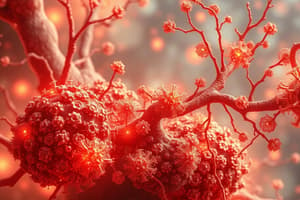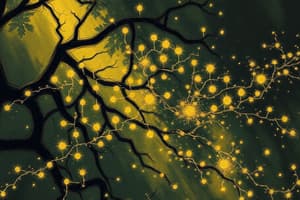Podcast
Questions and Answers
What is primarily generated during the respiratory burst in macrophages and neutrophils?
What is primarily generated during the respiratory burst in macrophages and neutrophils?
- Reactive Oxygen Species (correct)
- Hydrogen Peroxide
- Nitric Oxide
- Hydroxy radicals
Which enzyme catalyzes the conversion of superoxide radical into hydrogen peroxide?
Which enzyme catalyzes the conversion of superoxide radical into hydrogen peroxide?
- Glutathione Peroxidase
- Catalase
- NADPH-Oxidase
- Superoxide Dismutase (correct)
Which antioxidant system uses glutathione to reduce hydrogen peroxide?
Which antioxidant system uses glutathione to reduce hydrogen peroxide?
- Thioredoxin-centered system
- Catalase system
- Glutathione-centered system (correct)
- Superoxide dismutase system
What is the primary role of antioxidants in living organisms?
What is the primary role of antioxidants in living organisms?
How does catalase function in relation to hydrogen peroxide?
How does catalase function in relation to hydrogen peroxide?
Which complex of the electron transport chain is responsible for transferring electrons from NADH to coenzyme Q (UQ)?
Which complex of the electron transport chain is responsible for transferring electrons from NADH to coenzyme Q (UQ)?
What is a distinguishing feature of Complex-2 in the electron transport chain?
What is a distinguishing feature of Complex-2 in the electron transport chain?
During the transfer of electrons from NADH to UQ by Complex-1, how many protons are pumped into the intermembrane space?
During the transfer of electrons from NADH to UQ by Complex-1, how many protons are pumped into the intermembrane space?
How does Complex-3 contribute to the electron transport chain?
How does Complex-3 contribute to the electron transport chain?
Which of the following statements about Complex-4 is correct?
Which of the following statements about Complex-4 is correct?
What is the main function of sphingomyelin in nerve cells?
What is the main function of sphingomyelin in nerve cells?
Which class of molecules does ceramide belong to?
Which class of molecules does ceramide belong to?
What type of bond connects the monosaccharides in glycolipids to ceramide?
What type of bond connects the monosaccharides in glycolipids to ceramide?
Which type of glycolipid is characterized by the presence of one or more sialic acid residues?
Which type of glycolipid is characterized by the presence of one or more sialic acid residues?
What is the structural unit of isoprenoids?
What is the structural unit of isoprenoids?
What is the role of cytochrome c during electron transfer?
What is the role of cytochrome c during electron transfer?
How many H+ ions are pumped out from the matrix when electrons are transferred from cyt c to O2?
How many H+ ions are pumped out from the matrix when electrons are transferred from cyt c to O2?
What is the main function of ATP synthase?
What is the main function of ATP synthase?
Which statement accurately describes the chemiosmotic theory?
Which statement accurately describes the chemiosmotic theory?
What effect does ATP have on cytochrome oxidase?
What effect does ATP have on cytochrome oxidase?
How many protons need to be translocated for the synthesis of one molecule of ATP?
How many protons need to be translocated for the synthesis of one molecule of ATP?
What is a characteristic feature of the structure of ATP synthase?
What is a characteristic feature of the structure of ATP synthase?
What occurs when uncouplers like Dinitrophenol are introduced?
What occurs when uncouplers like Dinitrophenol are introduced?
What does the number after the colon in a fatty acid abbreviation indicate?
What does the number after the colon in a fatty acid abbreviation indicate?
Which of the following fatty acids is classified as an essential fatty acid?
Which of the following fatty acids is classified as an essential fatty acid?
What is a characteristic of triacylglycerols?
What is a characteristic of triacylglycerols?
Which fatty acid is the precursor for 𝛶-linoleic acid?
Which fatty acid is the precursor for 𝛶-linoleic acid?
What is one of the main health benefits of omega-3 fatty acids?
What is one of the main health benefits of omega-3 fatty acids?
Which type of phospholipid is composed of a glycerol backbone, two fatty acids, and a phosphate group?
Which type of phospholipid is composed of a glycerol backbone, two fatty acids, and a phosphate group?
How do eicosanoids derived from omega-6 fatty acids generally function in the body?
How do eicosanoids derived from omega-6 fatty acids generally function in the body?
What is saponification?
What is saponification?
Which of the following statements about waxes is true?
Which of the following statements about waxes is true?
What is the primary function of phosphatidylcholine?
What is the primary function of phosphatidylcholine?
What distinguishes fats from oils?
What distinguishes fats from oils?
Which essential fatty acid cannot be synthesized by mammals?
Which essential fatty acid cannot be synthesized by mammals?
The ratio of omega-6 to omega-3 fatty acids in the diet is believed to be healthiest at which range?
The ratio of omega-6 to omega-3 fatty acids in the diet is believed to be healthiest at which range?
Flashcards are hidden until you start studying
Study Notes
Electron Transport Chain
- The Electron Transport Chain (ETC) is located in the inner membrane of mitochondria. It consists of four protein complexes: Complex I, Complex II, Complex III, and Complex IV.
- Complex I (NADH Dehydrogenase Complex) transfers electrons from NADH to ubiquinone (UQ), pumping four protons (H+) from the matrix into the intermembrane space.
- Complex II (Succinate Dehydrogenase Complex) transfers electrons from FADH2 to UQ, but does not pump protons.
- Complex III (Cytochrome bc1 Complex) transfers electrons from reduced UQ (UQH2) to cytochrome c (Cyt c), pumping four protons across the membrane.
- Complex IV (Cytochrome c Oxidase) transfers four electrons from four Cyt c to oxygen (O2) to form water (H2O), also pumping four protons.
Energy Relationships in ETC
- Oxidation of NADH releases significant energy, which is used to pump protons, creating a proton gradient for ATP production.
- The ETC generates 2.5 ATP molecules per NADH and 1.5 ATP molecules per FADH2.
Oxidative Phosphorylation and Chemiosmotic Theory
- Oxidative phosphorylation is the process of conserving energy from the ETC by phosphorylating ADP to ATP.
- Chemiosmotic Coupling Theory explains how the proton gradient generated by ETC drives ATP synthesis by ATP synthase.
Evidence for the Chemiosmotic Theory
- The pH of a weakly buffered mitochondrial suspension decreases during active respiration, indicating proton pumping.
- Disrupting the inner membrane stops respiration.
- Uncouplers like Dinitrophenol collapse the proton gradient, disrupting ATP synthesis.
- Ionophores like Gramicidin A form channels that allow protons to pass freely, also disrupting the gradient.
ATP Synthase Structure
- ATP synthase consists of two rotors linked by a flexible stator.
- It has two major components: F1 unit (ATP synthase) and F0 unit (transmembrane channel).
- F1 unit has five subunits: 3α, 3β, γ, δ, and ε.
- F0 unit has three subunits: a, 2b, and 12c.
- The F0 unit converts proton motive force into rotational force of the central shaft (γ and ε subunits), driving ATP synthesis by F1.
- Three proton translocations are needed for one ATP molecule synthesis.
Respiratory Burst
- The Respiratory Burst describes the rapid production of reactive oxygen species (ROS) by macrophages and neutrophils to destroy pathogens.
- Phagocytosis of pathogens by macrophages and neutrophils leads to the formation of phagosomes.
- NADPH-oxidase on the phagolysosome membrane converts O2 to superoxide radicals (O2-), which then react with other molecules to generate highly reactive free radicals like OH, -OCL, ONOO-, and NO2.
- These free radicals destroy bacteria.
Antioxidants
- To protect against oxidative stress, living organisms possess various antioxidant defense mechanisms.
- Enzyme systems like superoxide dismutase (SOD), catalase, glutathione-centered system, and thioredoxin-centered system play crucial roles.
- Molecular systems like α-tocopherol (Vitamin E), β-carotene (Vitamin A), and ascorbic acid (Vitamin C) are also vital for protecting against oxidative damage.
Enzyme Systems Antioxidants
- Superoxide Dismutase (SOD) converts two superoxide radicals into hydrogen peroxide (H2O2) and oxygen (O2).
- Catalase degrades H2O2 into water (H2O) and O2.
- Glutathione-centered system involves glutathione peroxidase and glutathione reductase.
- Glutathione peroxidase uses glutathione (GSH) to reduce H2O2 and organic peroxides, converting them to water and alcohols. This reaction oxidizes GSH to GSSG.
Fatty Acid Abbreviation using 𝜔 Number System
- The 𝜔 number system describes the location of the first double bond in a fatty acid.
- The number before the colon represents the number of carbons in the fatty acid.
- The number after the colon indicates the number of double bonds.
- The number after the 𝜔 indicates the position of the first double bond from the 𝜔 (methyl) end.
- For example, Linoleic Acid (18:2𝜔-6) is an 𝜔-6 fatty acid.
Essential and Nonessential Fatty Acids
- Plants and bacteria synthesize all the required fatty acids, while animals acquire most from their diet.
- Nonessential fatty acids can be synthesized by animals, while essential fatty acids must be obtained from the diet.
- Linoleic acid (Omega-6 Fatty Acids) and α-linolenic acid (Omega-3 Fatty acids) are essential fatty acids.
𝜔-6 Fatty Acids
- Linoleic Acid is the precursor for many derivatives, including γ-linoleic acid, arachidonic acid, and docosapentanenoic acid (DPA).
- Food sources of 𝜔-6 fatty acids include vegetable oils, eggs, and poultry.
𝜔-3 Fatty Acids
- α-linolenic acid is the precursor for eicosapentaenoic acid (EPA) and docosahexaenoic acid (DHA).
- Sources of 𝜔-3 fatty acids include flaxseeds, soybean oils, walnuts, fish, and fish oils.
- Health benefits of 𝜔-3 fatty acids include promoting cardiovascular health, lowering blood triacylglycerol levels, reducing blood pressure, and decreasing platelet aggregation.
Beneficial role of 𝜔-6 and 𝜔-3 Fatty Acids
- Eicosanoids are hormone-like molecules derived from 𝜔-6 and 𝜔-3 fatty acids.
- They include prostaglandins, thromboxanes, and leukotrienes, which regulate various functions.
- 𝜔-6 derived eicosanoids promote inflammation, while 𝜔-3 derived eicosanoids are anti-inflammatory.
- The ratio of 𝜔-6 to 𝜔-3 fatty acids in the diet influences the synthesis of inflammatory and anti-inflammatory eicosanoids.
Triacylglycerols
- Triacylglycerols (Triglycerides) are esters of glycerol with three fatty acids.
- They are neutral fats with no charge, containing a mixture of saturated and unsaturated fatty acids.
- Monoacylglycerols and diacylglycerols are intermediates with one or two fatty acids attached to glycerol.
Properties of Triacylglycerols
- Triacylglycerols are classified as fats or oils depending on their fatty acid composition.
- Fats are solid at room temperature, having a high saturated fatty acid content.
- Oils are liquid at room temperature, having a high unsaturated fatty acid content.
Saponification
- Saponification is the process of producing soap by hydrolyzing triacylglycerol with KOH or NaOH.
- The process results in glycerol and Na or K salts of fatty acids, which form soap.
- Soap acts as an emulsifying agent, dispersing grease and oil drops into micelles.
Wax Esters
- Waxes are complex mixtures of nonpolar lipids that provide protective coatings on plants and animals.
- They consist of long-chain fatty acids esterified with long-chain alcohols, for example, beeswax.
Phospholipids
- Phospholipids are amphipathic molecules with a polar head group (phosphate and charged groups) and hydrophobic fatty acid tails.
- When in water, phospholipids spontaneously form ordered structures such as lipid monolayers, micelles, and bilayer vesicles.
- Phospholipids are essential for cell membrane structure.
Phospholipids
- There are two main types of phospholipids: phosphoglycerides and sphingolipids.
- Phosphoglycerides contain glycerol, two fatty acids, a phosphate group, and an alcohol.
- The simplest phosphoglyceride is phosphatidic acid, which consists of glycerol-3-phosphate and two fatty acids.
- Phosphatidylcholine (lecithin) is an example of a phosphoglyceride with choline esterified to the phosphate group.
Phosphatidylcholine, Phosphatidylserine, and Phosphatidylglycerol
- Phosphatidylcholine (PC) (Lecithin) is a major component of biological membranes and acts as a surfactant.
- Phosphatidylserine (PS) is another key component of biological membranes and acts as a signal for macrophages to engulf cells.
- Phosphatidylglycerol is found in the lungs and serves as a surfactant, also present in amniotic fluid as a fetal lung maturity indicator.
Phosphatidylethanolamine and Diphosphatidylglycerol
- Phosphatidylethanolamine and Diphosphatidylglycerol have smaller polar heads and are primarily found in the inner leaflet of membranes.
- Phosphatidylethanolamine is also known as cephalin.
Acyltransferase and Phospholipases
- Acyltransferases add fatty acids to phosphoglycerides, while phospholipases remove fatty acids.
Sphingolipids
- Sphingolipids consist of sphingomyelin and glycolipids.
- The core structure of sphingolipids is ceramide, which is composed of sphingosine and a fatty acid.
Sphingomyelin
- In sphingomyelin, the OH group of ceramide is esterified to the phosphate group of either phosphorylcholine or phosphorylethanolamine.
- Sphingomyelin is an important sphingolipid, aiding in nerve insulation and rapid nerve impulse transmission.
Glycolipids
- Glycolipids have monosaccharides, disaccharides, or oligosaccharides attached to ceramide via O-glycosidic bonds.
- Found on the extracellular face of eukaryotic cell membranes, they contribute to membrane stability, cell-cell interactions, and act as receptors for viruses and pathogens.
- Main classes of glycolipids include cerebrosides, sulfatides, and gangliosides.
Cerebrosides and Sulfatides
- Cerebrosides contain a monosaccharide as the head group.
- Galactocerebrosides are found in brain cell membranes.
- Sulfatides are negatively charged at physiological pH and are sulfated cerebrosides.
Gangliosides
- Gangliosides contain oligosaccharide groups with one or more sialic acid residues.
- They are present in most animal cells, and GM2 is involved in Tay-Sachs disease.
Isoprenoids
- Isoprene is a 5-carbon structural unit.
- Many biomolecules contain repeating isoprene units.
- Two isoprene units form monoterpenes, used in perfumes.
- Tetraterpenes include carotenoids.
- Steroids are derived from triterpenes with four fused rings, for example, cholesterol.
Studying That Suits You
Use AI to generate personalized quizzes and flashcards to suit your learning preferences.





